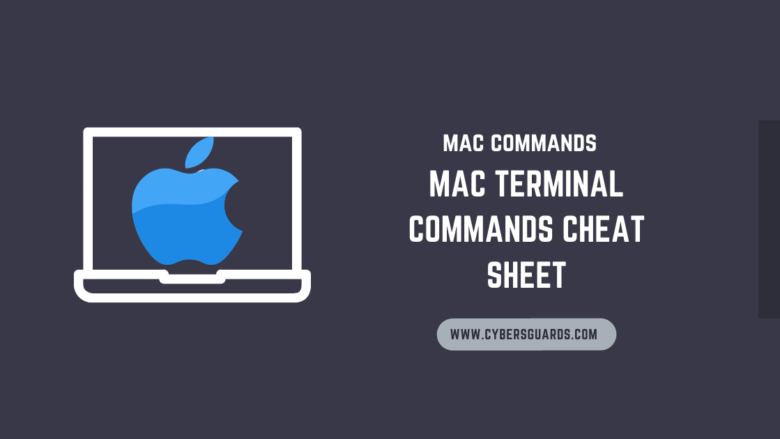Our mega cheat sheet of Mac terminal commands provides a great reference for all the important commands you should know.
Because macOS is a user-friendly operating system, you won’t have to spend much time learning the basics; given this, why should you learn and use the Unix command line on your Mac? There are four compelling reasons for this:
There are dozens of open source and free Unix-based programs available. There’s no need to spend money on these.
- When Spotlight isn’t finding what you’re looking for, you can use Unix search tools. They’re a lot stronger than Spotlight.
- You can automate the management of files, folders, and file archives. Setting up a cron job will take care of this for you.
- It provides you more control over your system and gives you more power.
- It’s difficult to remember and utilize all of the Mac commands because there are so many. We’re here to help with a comprehensive list of Mac Terminal commands that you may use to boost your system’s efficiency.
The Terminal app may be found in Applications > Utilities or by searching for it in Spotlight. Then use some of the powerful commands listed below to get started.
The Mac Terminal Commands Cheat Sheet
| COMMAND | ACTION |
|---|---|
| Shortcuts | |
| Tab | Auto-complete file and folder names |
| Ctrl + A | Go to the beginning of the line you’re currently typing on |
| Ctrl + E | Go to the end of the line you’re currently typing on |
| Ctrl + U | Clear the line before the cursor |
| Ctrl + K | Clear the line after the cursor |
| Ctrl + W | Delete the word before the cursor |
| Ctrl + T | Swap the last two characters before the cursor |
| Esc + T | Swap the last two words before the cursor |
| Ctrl + L | Clear the screen |
| Ctrl + C | Kill whatever you’re running |
| Ctrl + D | Exit the current shell |
| Option + → | Move cursor one word forward |
| Option + ← | Move cursor one word backward |
| Ctrl + F | Move cursor one character forward |
| Ctrl + B | Move cursor one character backward |
| Ctrl + Y | Paste whatever was cut by the last command |
| Ctrl + Z | Puts whatever you’re running into a suspended background process |
| Ctrl + _ | Undo the last command |
| Option + Shift + Cmd + C | Copy plain text |
| Shift + Cmd + V | Paste the selection |
| exit | End a shell session |
| Basics | |
| / (Forward Slash) | Top level directory |
| . (Single Period) | Current directory |
| .. (Double Period) | Parent directory |
| ~ (Tilde) | Home directory |
| sudo [command] | Run command with the security privileges of the super user |
| nano [file] | Opens the Terminal editor |
| open [file] | Opens a file |
| [command] -h | Get help about a command |
| man [command] | Show the help manual of the command |
| Change Directory | |
| cd | Home directory |
| cd [folder] | Change directory, e.g. cd Documents |
| cd ~ | Home directory |
| cd/ | Root of the drive |
| cd – | Previous directory or folder you last browsed |
| pwd | Show your working directory |
| cd.. | Move up to the parent directory |
| cd../.. | Move up two levels |
| List Directory Contents | |
| ls | Display the name of files and subdirectories in the directory |
| ls -C | Force multi-column output of the listing |
| ls -a | List all entries including those with .(period) and ..(double period) |
| ls -1 | Output the list of files in one entry per line format |
| ls -F | Display a / (slash) immediately after each path that is a directory, * (asterisk) after executable programs or scripts, and @ after a symbolic link |
| ls -S | Sort files or entries by size |
| ls -l | List in a long format. Includes file mode, owner and group name, date and time file was modified, pathname, and more |
| ls -l / | List of the file system from root with symbolic links |
| ls -lt | List the files sorted by time modified (most recent first) |
| ls -lh | Long listing with human readable file sizes in KB, MB, or GB |
| ls -lo | List the file names with size, owner, and flags |
| ls -la | List detailed directory contents, including hidden files |
| File Size and Disk Space | |
| du | List usage for each subdirectory and its contents |
| du -sh [folder] | Human readable output of all files in a directory |
| du -s | Display an entry for each specified file |
| du -sk* | sort -nr | List files and folders, totaling the size including the subfolders. Replace sk* with sm* to list directories in MB |
| df -h | Calculate your system’s free disk space |
| df -H | Calculate free disk space in powers of 1,000 (as opposed to 1,024) |
| File and Directory Management | |
| mkdir <dir> | Create new folder named <dir> |
| mkdir -p <dir>/<dir> | Create nested folders |
| mkdir <dir1> <dir2> <dir3> | Create several folders at once |
| mkdir “<dir>” | Create a folder with a space in the filename |
| rmdir <dir> | Delete a folder (only works on empty folders) |
| rm -R <dir> | Delete a folder and its contents |
| touch <file> | Create a new file without any extension |
| cp <file> <dir> | Copy a file to the folder |
| cp <file> <newfile> | Copy a file to the current folder |
| cp <file>~/<dir>/<newfile> | Copy a file to the folder and rename the copied file |
| cp -R <dir> <“new dir”> | Copy a folder to a new folder with spaces in the filename |
| cp -i <file><dir> | Prompts you before copying a file with a warning overwrite message |
| cp <file1> <file2> <file3>/Users/<dir> | Copy multiple files to a folder |
| ditto -V [folder path][new folder] | Copy the contents of a folder to new folder. In here “-V” print a line of status for every file copied |
| rm <file> | Delete a file (This deletes the file permanently; use with caution.) |
| rm -i <file> | Delete a file only when you give confirmation |
| rm -f <file> | Force removal without confirmation |
| rm <file1> <file2> <file3> | Delete multiple files without any confirmation |
| mv <file> <newfilename> | Move/rename |
| mv <file> <dir> | Move a file to the folder, possibly by overwriting an existing file |
| mv -i <file> <dir> | Optional -i flag to warn you before overwriting the file |
| mv *.png ~/<dir> | Move all PNG files from current folder to a different folder |
| Command History | |
| Ctrl + R | Search through previously used commands |
| history n | Shows the previous commands you’ve typed. Add a number to limit to the last n items |
| ![value] | Execute the last command typed that starts with a value |
| !! | Execute the last command typed |
| Permissions | |
| ls -ld | Display the default permission for a home directory |
| ls -ld/<dir> | Display the read, write, and access permission of a particular folder |
| chmod 755 <file> | Change the permission of a file to 755 |
| chmod -R 600 <dir> | Change the permission of a folder (and its contents) to 600 |
| chown <user>:<group> <file> | Change the ownership of a file to user and group. Add -R to include folder contents |
| Processes | |
| ps -ax | Output currently running processes. Here, a shows processes from all users and x shows processes that are not connected with the Terminal |
| ps -aux | Shows all the processes with %cpu, %mem, page in, PID, and command |
| top | Display live information about currently running processes |
| top -ocpu -s 5 | Display processes sorted by CPU usage, updating every 5 seconds |
| top -o rsize | Sort top by memory usage |
| kill PID | Quit process with ID <PID>. You’ll see PID as a column in the Activity Monitor |
| ps -ax | grep <appname> | Find a process by name or PID |
| Network | |
| ping <host> | Ping host and display status |
| whois <domain> | Output whois info for a domain |
| curl -O <url/to/file> | Download file via HTTP, HTTPS, or FTP |
| ssh <username>@<host> | Establish SSH connection to <host> with user <username> |
| scp <file><user>@<host>:/remote/path | Copy <file> to a remote <host> |
| arp -a | View a list of all devices on your local network. It will show you the IP and MAC address of all the devices |
| ifconfig en0 | View your device IP and MAC address |
| traceroute [hostname] | Identify the path and the hops traversed by the packets from your device to the destination address |
| Homebrew | |
| brew doctor | Check brew for potential problems |
| brew help | List of useful homebrew formula and cask commands |
| brew install <formula>|<cask> | Install a formula or cask |
| brew uninstall <formula>|cask> | Uninstall a formula or cask |
| brew list –formula | List only installed formulas |
| brew list –cask | List only installed cask |
| brew deps <formula>|<cask> | List all the dependencies of a formula or cask |
| brew search text|/regex/ | Search formula or cask through regex |
| brew upgrade <formula>|<cask> | Upgrade the formula or cask |
| brew outdated <formula>|<cask> | Search for outdated formula or cask |
| brew outdated –formula | Search for outdated formula |
| brew outdated –cask | Search for outdated cask |
| brew pin [installed_formula] | Pin a formula from getting upgraded |
| brew unpin [installed_formula] | Unpin to upgrade a package |
| brew cleanup | Remove stale lock files and outdated packages for all formula and casks. |
| Environment Variable or Path | |
| printenv | Display a list of currently set environment variables. Also tells you which shell you’re using |
| $echo | Tells the terminal to print something and show it to you |
| echo $PATH | Check the value of the PATH variable which storea a list of directories with executable files |
| echo $PATH >path.txt | Export the path directory to a text file |
| export PATH=$PATH:absolute/path to/program/ | Execute a program via terminal only in your current session. If you use a program regularly, add the path to shell configuration file. |
| Search | |
| find <dir> -name <“file”> | Find all files named <file> inside <dir>. Use wildcards (*) to search for parts of filenames |
| grep “<text>” <file> | Output all occurrences of <text> inside <file> (add -i for case insensitivity) |
| grep -rl “<text>” <dir> | Search for all files containing <text> inside <dir> |
| Output | |
| cat <file> | Output the content of <file> |
| less <file> | Output the contents of <file> using the less command that supports pagination and more |
| head <file> | Output the first 10 lines of <file> |
| <cmd> > > <file> | Appends the output of <cmd> to <file> |
| <cmd> > <file> | Direct the output of <cmd> into <file> |
| <cmd1> | <cmd2> | Direct the output of <cmd1> to <cmd2> |
Customize the Terminal after that
This cheat sheet contains a large number of commands. But you don’t have to study them all at once! Instead, choose a combination that works well with your process and saves you the most time. Once you’ve learned these commands, there’s still a lot more to learn about the Terminal to help you get the most out of it.
Conclusion
I hope you found this information helpful. Please fill out the form below if you have any queries or comments.
What are bash commands, and how do I use them?
Bash (also known as Bourne Again Shell) is an interpreter for shell commands. A shell interpreter receives plain text commands and attempts to execute them by calling OS services. The ls command, for example, displays a directory’s files and folders. Bash is a more advanced version of sh (Bourne Shell).
Is the Mac terminal identical to the Linux terminal?
As you may have gathered from my introduction essay, macOS is a type of UNIX that is similar to Linux. However, unlike Linux, macOS does not come with virtual terminals installed by default. Instead, you’ll utilize the Terminal program (/Applications/Utilities/Terminal) to get a BASH shell and an instruction terminal. The case of all instructions is important.
What is the purpose of Terminal on a Mac?
The Mac Terminal is a command system that can help you quickly grasp your operating system and make changes. It’s simple to get to the Terminal app on your Mac, either using the Finder or Spotlight.











FIND US ON SOCIALS